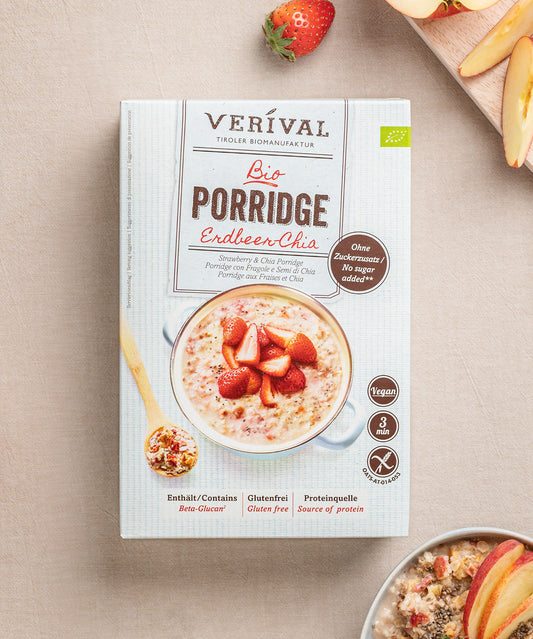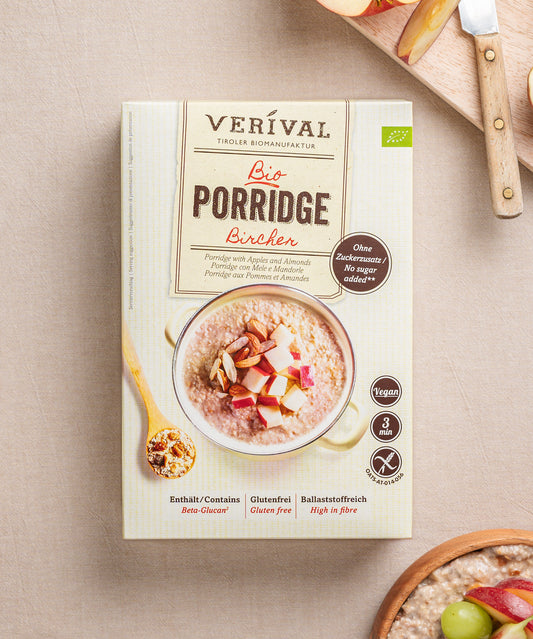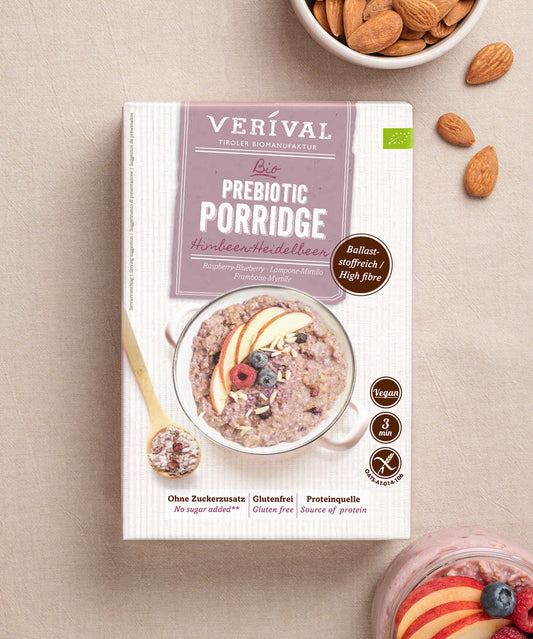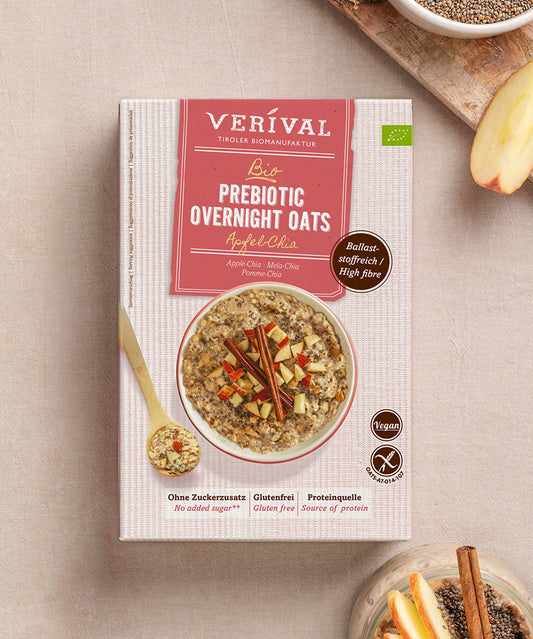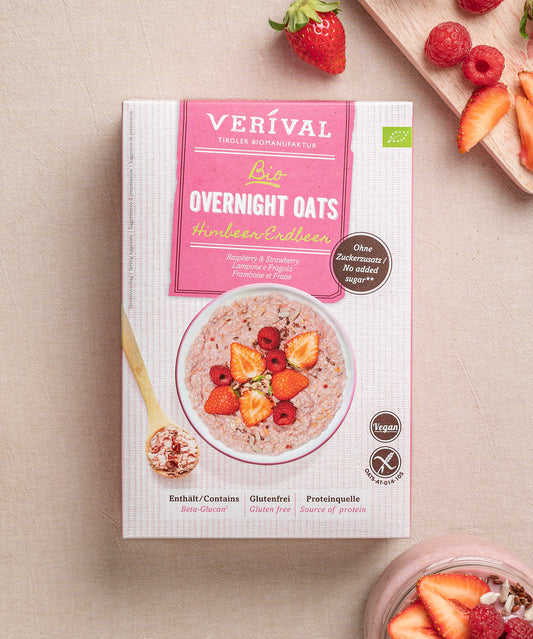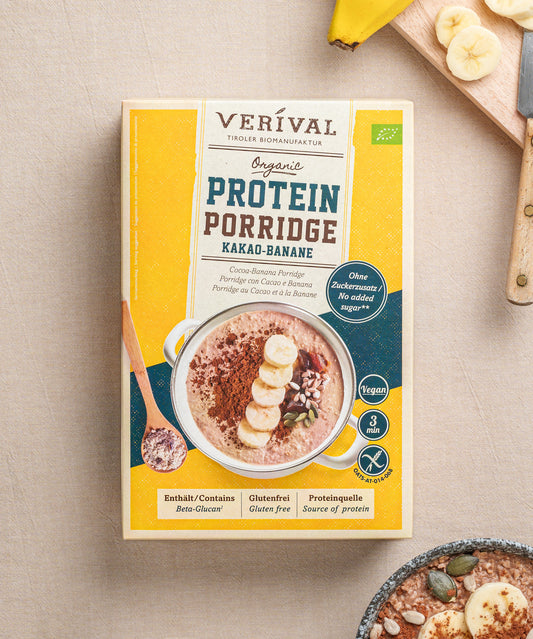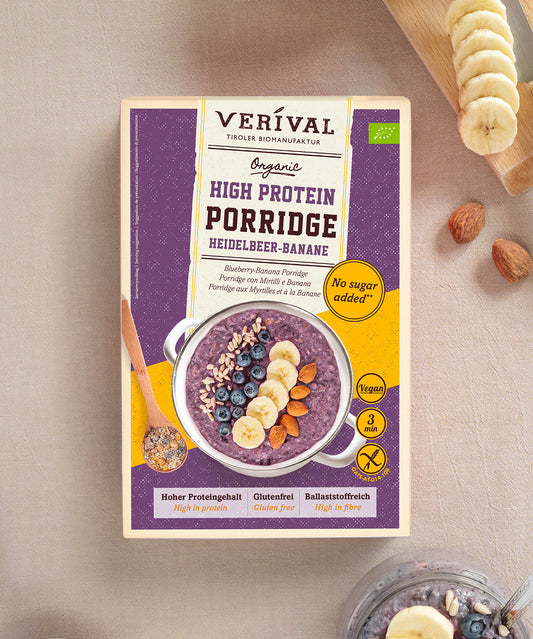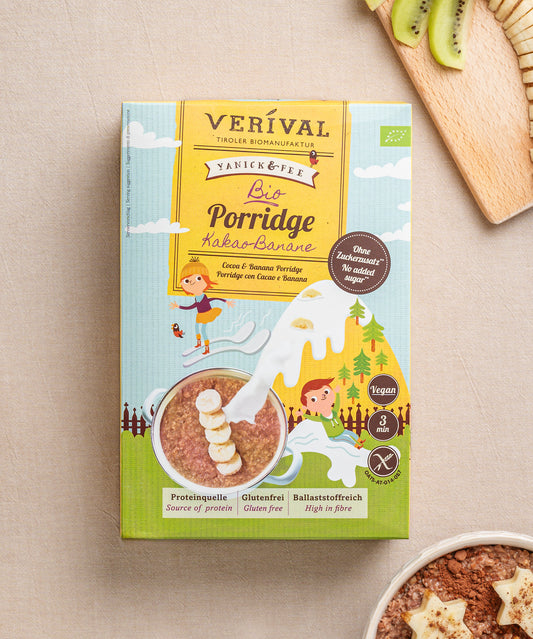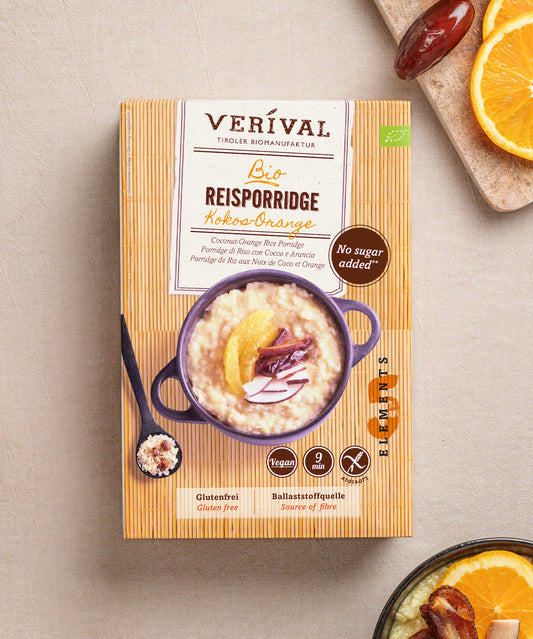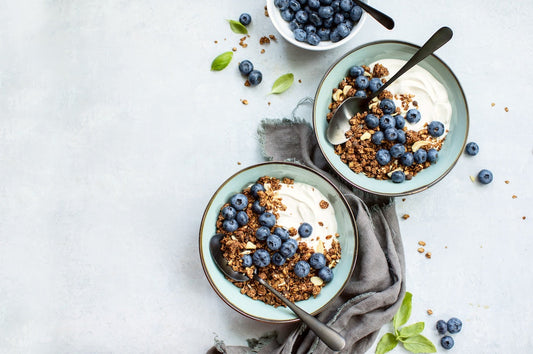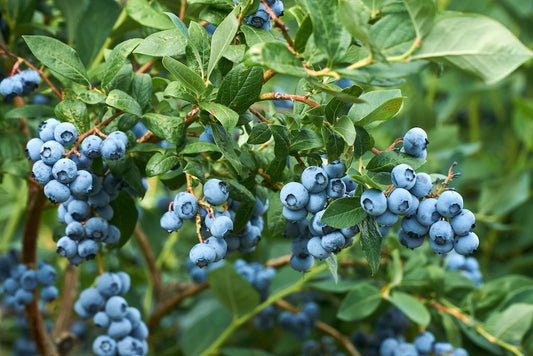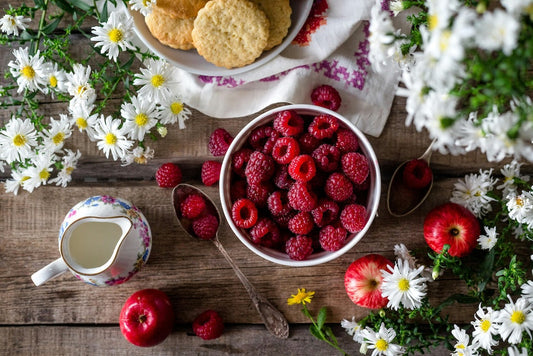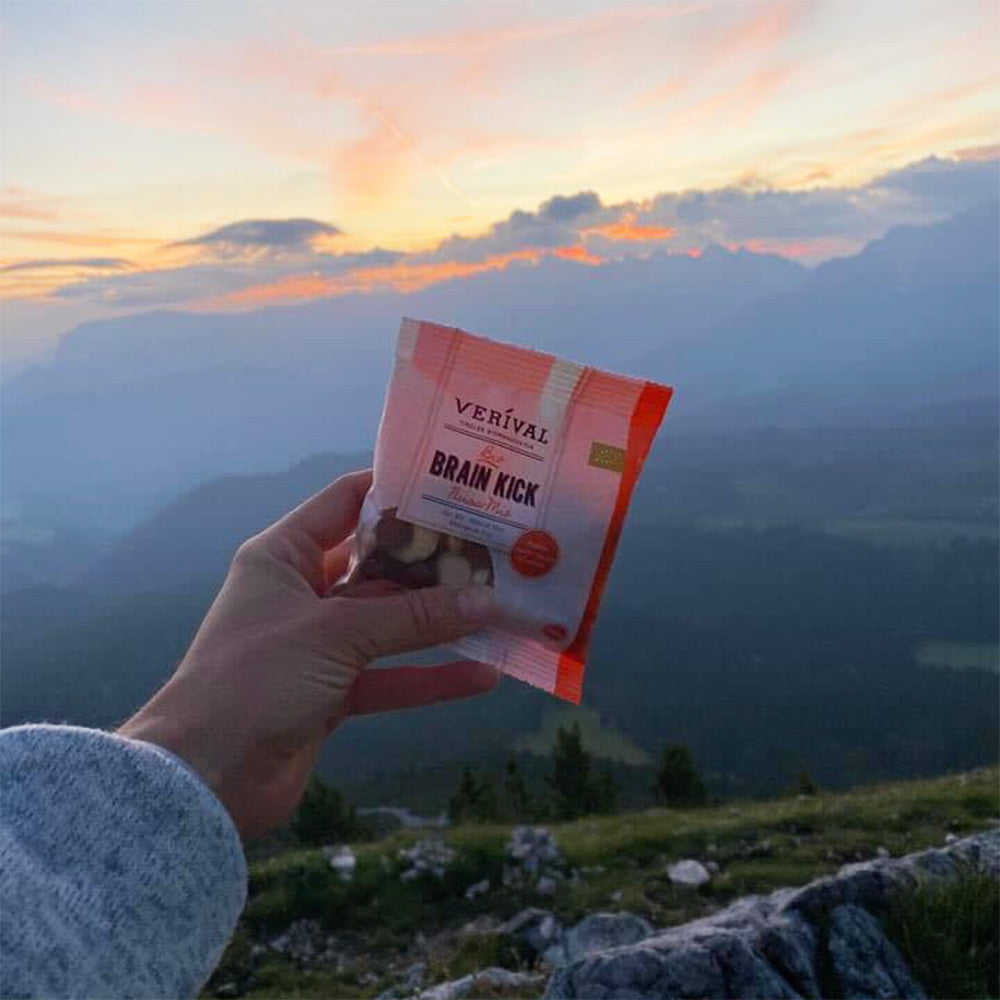Matcha, the green gold from Japan, has taken a very special place in today's tea culture. This powdered gem is not just a passing trend, but a lasting symbol of exquisite tea enjoyment. The term Matcha comes from Japanese and literally means “ground tea”. Japanese Matcha is a type of powdered green tea made from the leaves of the Camellia sinensis plant (Tencha variety).
Matcha is much more than just a drink. It embodies the tradition and history of Japan, while at the same time delighting the modern palate. It has come a long way from the ancient ceremonies of Zen monks to the hip cafes of metropolitan cities around the world.
Why we love matcha, why it has become such an iconic drink and ingredient, and why matcha is so healthy, you will learn in today's blog post.
Discover the variety of Verival porridges
The origin of Matcha
The roots of Matcha tea go back a long way in Japan's rich history, and its origin is closely linked to the country's traditional tea ceremonies. These ceremonies have not only shaped the green powder as a key ingredient, but also Japanese tea culture as a whole. This is another reason why the origin of Matcha is so important!
The story began over a thousand years ago, when Buddhist monks brought the first tea plants to Japan from China. These plants, including the Matcha plant, were cultivated in the monasteries, and the monks further developed the techniques for producing Matcha. It wasn't long before it had established itself as a popular drink in the monasteries and among the nobility.
The Japanese tea ceremonies, known as “chanoyu” or “sado,” were refined and popularized in the 16th century by the legendary tea master Sen no Rikyū. The powder played a central role in these ceremonies, which emphasized not only the enjoyment of tea, but also the principles of harmony, simplicity, respect, and purity.
Today, tea ceremony traditions are still alive and matcha is appreciated in Japan and around the world as a symbol of elegance and culture. Its historical roots make it clear that this green powder is much more than just a drink – it is a cultural heritage that embodies the essence of the Japanese way of life.
What is matcha, anyway?
What is matcha?
Matcha is not just any green tea, but a very special green powder that has captured the hearts of tea lovers around the world. Its special characteristics make it a unique and fascinating drink.
Unlike regular green tea, where the leaves are discarded after brewing, the whole tea plant is used for matcha. The leaves are ground into a fine powder that has an intense green color and strong flavor. This elaborate grinding process is one of the reasons for its high quality.
The cultivation of Matcha also differs from that of conventional green tea. The plants are shaded for about three weeks before harvesting. This shading promotes the production of chlorophyll and amino acids in the leaves, which in turn affects the taste and texture.
The history of matcha is closely linked to these cultivation and processing techniques, which have been perfected over the centuries. Its origin in Japan reflects the dedication and pursuit of perfection that are deeply rooted in Japanese culture.
Today, the main matcha growing regions are the local governments of Shizuoka, Uji, Kyoto and Kagoshima.
The history of matcha
The history of matcha goes back many centuries and is characterized by fascinating developments and cultural influences. It is a heritage that has been passed down from generation to generation and is still alive today.
The origins can be traced back to the Tang Dynasty in China (618-907 AD). It was then that the Chinese began grinding tea leaves into a powder, developing a forerunner to matcha. In the 12th century, these ideas were brought to Japan by Buddhist monks, where they were further developed and perfected.
The Japanese monks, in particular Eisai and Myōan Eisai, contributed significantly to its spread. They appreciated it not only as a delicious drink, but also as a means to promote meditation and mental clarity. The tea ceremonies, as perfected by Sen no Rikyū in the 16th century, helped to make matcha an integral part of Japanese culture.
It was also appreciated by the samurai class, as it gave them energy and focus. During the Edo period (17th-19th century), matcha became accessible to broader sections of the population, and demand grew.
History shows how this unique drink is rooted in Japan, from its cultural significance to its distinctive taste. But what does the green tea actually taste like? Let's take a look at the sensory aspects of this exquisite tea and understand why it is so popular.
More about the history of Matcha
What does the green gold actually taste like?
Matcha has a unique flavor that is both sophisticated and distinctive. At the first sip, a world of flavors and nuances unfolds, making the tea a real treat for the palate.
The flavor is often described as grassy, earthy, and slightly sweet. It has a pleasant bitterness that is not overpowering, and a touch of umami, which sets it apart from other green teas. The name “umami” describes a fifth flavor sense that is perceived as savory and spicy.
A comparison that is often used is that of spinach or fresh grass. The taste of matcha is reminiscent of the fresh vitality of green leaves and leaves a pleasant aftertaste.
The intensity of the flavor depends on the quality of the matcha. High-quality matcha is finely ground and offers a deeper complexity of flavors. It can be slightly sweet, creamy and slightly nutty. Depending on the method of preparation, both usucha (thin, light tea) and koicha (thicker, darker tea) can be prepared with matcha.
Matcha's distinctive flavor has inspired the creativity of baristas and chefs around the world. Popular drinks such as matcha latte and matcha smoothies have been developed to showcase the unique flavor in delicious and refreshing creations.
Matcha production and preparation
Popular matcha drinks: tea and latte
Matcha is not just a drink, but a versatile ingredient that can be enjoyed in various forms. The two most well-known drinks are the traditional tea and the modern latte. Both have their own charm and special preparation.
Tea: This is the original and traditional way to enjoy matcha. To prepare tea, you need high-quality powder, a bowl (chawan), a bamboo whisk (chasen) and hot water. One teaspoon of powder is sieved into the bowl, then hot water is added. The bamboo whisk is used to vigorously beat the tea until it is frothy and smooth. The tea has an intense flavor and a calming effect that is ideal for Zen meditation or as a moment of relaxation.
Latte: This is a more modern variation of matcha that is popular in many cafes and tea bars. Matcha latte is often prepared with milk and sometimes sweet syrup. You can use hot or cold milk and dissolve the powder in it. The mixture is then frothed to create a creamy texture. Matcha latte offers a milder note and a slightly sweet taste that is often more pleasant for beginners.
The popularity of these drinks shows how versatile matcha can be. While the preparation of matcha requires some practice, the unique taste and health benefits are well worth the effort.
Matcha preparation – learn more
The production of matcha powder
The production of matcha is a complex process that requires careful attention to ensure the quality and flavor of the final powder. This process involves several steps, starting with the cultivation of the special tea plants and ending with their processing into a fine powder.
The process begins with the selection of the right tea plants, also known as “Camellia sinensis”. Special varieties of this plant are used for matcha, which are known for their sweet taste and high levels of chlorophyll and amino acids.
The crucial stage in the production process is the shading of the tea plants. About four weeks before harvest, the plants are covered with shade nets to reduce sunlight. This shading promotes the production of chlorophyll and amino acids in the leaves, giving matcha its characteristic flavor and green color.
After harvesting, the leaves are gently steamed to stop their oxidation. The leaves are then dried and separated from the stems and veins. The dried leaves, now known as “tencha”, are then ground into a fine powder, which we know as matcha. Matcha powder is very reactive. This means that it quickly loses valuable ingredients. Therefore, it is important to ensure that the leaves are sufficiently cooled during the grinding process.
The manufacturing process is time-consuming and requires expertise. Careful selection of the tea plants, shading, and precise processing are crucial to the quality of the final product. The health benefits of matcha are closely tied to this manufacturing process, as the concentration of nutrients and amino acids in tencha and matcha is higher than in conventional green teas. In the next sections, we will take a closer look at these health benefits and understand why matcha is considered a superfood.
What exactly is organic matcha tea?
In organic matcha, chemical fertilizers are not used, which is why the famous umami flavor is missing. From a health perspective, organic matcha tea is highly recommended.
Shop your starter set for the perfect matcha preparation
Health benefits of the Japanese tea specialty
Matcha is not only considered a delicious drink, but also a real superfood that offers a wealth of health benefits. Its unique composition makes it a nutrient-rich addition to your diet.
Why is it so healthy?
One reason for the health benefits of matcha is its high concentration of antioxidants. Antioxidants are compounds that help fight free radicals in the body and reduce oxidative damage. Matcha is particularly high in a particular antioxidant called epigallocatechin gallate (EGCG), which is known for its anti-cancer properties and ability to promote heart health.
In addition, the green powder contains a wealth of vitamins and minerals, including vitamin C, vitamin A, potassium and iron. These nutrients support the immune system, skin health and overall vitality.
The antioxidants and other ingredients
Besides EGCG, the green gold also contains catechins, which also have strong antioxidant properties. These compounds can help slow the aging process and reduce the risk of chronic diseases. It also contains L-theanine, an amino acid that promotes relaxation without causing drowsiness. This explains why the tea is described as “soothing vigilance” and plays an important role in Japan's meditation tradition.
The health benefits are extensive, making it an excellent choice for anyone looking to optimize their diet. From promoting heart health to strengthening the immune system, Japanese green tea offers an impressive list of benefits that make it a valuable part of a healthy lifestyle.
Does green powder contain caffeine?
Yes, the green powder contains caffeine, although in varying amounts compared to coffee and conventional green tea. The exact amount of caffeine can vary depending on the quality and preparation, but is typically between 30 and 70 milligrams per teaspoon of powder, which is about the same amount as in a cup of espresso.
By comparison, a cup of coffee typically contains about 95 milligrams of caffeine, while a cup of conventional green tea contains about 30 milligrams. Therefore, it generally contains less caffeine than coffee, making it a gentler and longer-lasting source of energy.
The effects of caffeine in matcha are often described as more balanced because they interact with the amino acid L-theanine, which is present in matcha in higher concentrations. This combination promotes concentration and alertness without causing the typical caffeine side effects such as nervousness or energy crashes.
The effect of matcha on the body is therefore not only due to the caffeine, but also to the unique combination of caffeine and L-theanine.
Matcha and its effects
Matcha is much more than just an invigorating drink – it has an impressive effect on the body and mental well-being. These effects are closely related to the unique components of matcha.
Stress reduction through the amino acid L-theanine
One of the most outstanding effects of matcha is its ability to promote relaxation and stress reduction. This is mainly attributed to the amino acid L-theanine, which is found in high quantities in matcha. L-theanine has the remarkable ability to influence brain activity while promoting relaxation without causing drowsiness. This combination leads to a state of “soothing alertness” that increases concentration and reduces stress. This is why matcha is often referred to as “meditation in a cup”.
Antioxidants that protect against free radicals
Matcha is also rich in antioxidants, particularly epigallocatechin gallate (EGCG), which offers a wide range of health benefits. These antioxidants fight free radicals in the body that can cause cell damage and are associated with various diseases. Regular consumption can therefore help slow down the aging process and reduce the risk of heart disease, cancer and other chronic conditions.
The combination of L-theanine, caffeine and antioxidants makes it a drink that not only invigorates, but also promotes mental clarity and supports good health. It is a natural choice for those looking for a holistic approach to wellness and relaxation.
How to prepare and enjoy matcha
Preparing matcha requires some knowledge and care to get the best possible flavor experience. There are both traditional and modern preparation methods for enjoying matcha.
Traditional preparation:
1. Tools: You will need a bowl (chawan), a bamboo whisk (chasen), and a bamboo spoon (chashaku).
2. Measure the matcha: Use the bamboo scoop to sieve about 1 to 1.5 teaspoons of powder into the bowl.
3. Hot water: Heat about 60-70 ml of hot, but not boiling water.
4. Pour in the water: Pour the hot water over the powder in the bowl.
5. Whisking: Use the bamboo whisk to whisk the powder and water into a smooth, frothy drink until there are no more lumps. Move the whisk in a W-shaped motion until a fine foam forms.
6. Enjoy: Drink the tea pure, straight from the bowl.
Modern preparation (in the form of latte):
1. Tools: You will need powder, milk (can also be plant-based milk), a whisk, and optional sweet syrup.
2. Mix matcha and milk: Mix 1-2 teaspoons of powder with a small amount of hot water to form a paste. Then add warm milk and whisk the mixture well until it is frothy.
3. Sweeten: If desired, add sweet syrup to adjust the flavor.
4. Serve: Pour the latte into a cup and enjoy it warm or cold.
For the perfect latte, we recommend using high-quality powder and adjusting the amount according to your taste.
Japanese green tea in combination with other foods
Here are some ways you can enjoy the green powder in combination with other foods:
Ice cream: the intense green color and unique flavor of matcha give ice cream a special touch.
Smoothies: add a teaspoon of powder to your favorite smoothie for a healthy energy boost and a pleasant green color.
Pancakes: Bake delicious pancakes by mixing matcha powder into the batter and serve them with fresh fruit and maple syrup.
Chocolate: Matcha and dark chocolate complement each other perfectly. You can make the chocolate yourself or use it as an ingredient in pastries.
Soda: Combine matcha with fresh lemon and a little sweetness to make a refreshing soda.
Yogurt: Stir the powder into plain yogurt for a healthy and flavorful snack.
Porridge: You can also incorporate matcha powder into your breakfast by mixing it with oatmeal and boiling it up.
The versatility of the green gold allows you to indulge your culinary creativity and discover a wide range of flavors. Combining matcha with different foods opens up a world of taste experiences.
A particularly nutritious and delicious way to enjoy matcha is with our Verival Matcha Porridge. This product perfectly combines high-quality matcha with oats to give you a healthy and tasty start to the day.
Why not try matcha porridge with dates and banana?
Conclusion
In the world of teas, matcha is undoubtedly more than just a cup of tea. It is a unique green powder that comes with a rich history, a variety of preparation methods and an impressive list of health benefits. This conclusion provides a summary of the main points that we have covered in this blog post.
Matcha is deeply rooted in Japanese tea culture and plays a significant role in traditional tea ceremonies. Its history goes back over a thousand years, and its production requires careful attention and craftsmanship.
What makes it so special is its unique production process. The shading of the tea plants, the harvest, the steaming and the fine grinding result in an intense green powder that offers outstanding quality compared to conventional green tea.
The flavor of matcha is distinctive, with a blend of grassiness, umami, and a slight sweetness. Popular drinks like matcha tea and matcha latte offer different flavors and preparation methods to suit every taste.
The green gold is not only delicious, but also extremely healthy. It is rich in antioxidants, including the powerful EGCG, and contains the amino acid L-theanine, which promotes relaxation and alertness. The combination of caffeine and L-theanine provides a gentle energy boost without the usual caffeine side effects.
Overall, matcha is more than just a tea; it is a living tradition, a superfood, and a culinary inspiration. It offers a comprehensive experience for body and mind and deserves its place in modern tea culture and cuisine.
Frequently asked questions
What is matcha good for?
Matcha is not only a traditional drink from Japan, but also offers a variety of health benefits. Thanks to its high antioxidant content, matcha can effectively fight free radicals in the body that are responsible for cell damage. Furthermore, the amino acid L-theanine it contains promotes relaxation and at the same time helps to increase concentration without causing restlessness or nervousness. In addition, there are studies that suggest regular consumption of matcha can support heart health by keeping cholesterol levels in balance and regulating blood pressure. Thus, matcha is not only a tasty drink, but also a useful companion for a healthy life.
Is matcha really healthy?
Matcha, a traditional green tea from Japan, is often praised for its numerous health benefits. It is particularly rich in antioxidants, which help the body fight free radicals. One of the special features of matcha is its high concentration of L-theanine, an amino acid known for its relaxing properties. This, combined with its health benefits, makes matcha a popular drink for many.
How much matcha a day is healthy?
It is recommended to drink 1-2 cups of matcha daily to reap its health benefits without risking an overdose of caffeine. As with anything, the green tea powder should be enjoyed in moderation to avoid possible side effects.
Can you lose weight with matcha?
Matcha is often associated with weight loss. It is known to boost the metabolism and can reduce appetite, which can be helpful if you are trying to lose weight. But it is important to stress that matcha alone is not a miracle cure for weight loss. A healthy diet and regular exercise are still key.
What is matcha?
Matcha is a special green tea from Japan. The tea leaves are ground into a fine powder and then mixed with hot water. This gives matcha its characteristic strong flavor and vibrant green color.
How does matcha taste?
Matcha offers a unique taste experience. It has an earthy and grassy profile accompanied by a subtle sweetness. The characteristic umami flavor of matcha tea powder makes it particularly distinctive.
What is matcha powder?
Matcha powder is the end product of grinding tencha leaves. Before harvesting, the tea leaves are shaded to intensify their flavor and color. The leaves are then ground into a fine powder in traditional stone mills, specifically granite stone mills.
What is the difference between matcha and green tea?
Although matcha and green tea both come from the tea plant, they are different in how they are produced and how they are consumed. While matcha is a powder that is consumed whole, green tea is drunk in leaf form and the leaves are discarded afterwards.
Where does matcha come from?
Matcha has its roots in Japan, where it has been an integral part of the Japanese tea ceremony for centuries. It is believed that Buddhist monks first introduced tea to Japan and its popularity has only increased since.
Does matcha have a calming effect?
Yes, despite its caffeine content, matcha is known to have a calming effect on the body and mind. This is due to the presence of L-theanine, an amino acid that promotes relaxation.
Which contains more caffeine: matcha or coffee?
Although matcha contains caffeine, a typical serving has less caffeine than a cup of coffee. Nevertheless, matcha has a higher caffeine content compared to conventional green tea.
What is organic matcha tea?
Organic matcha differs from conventional matcha in that no chemical fertilizers are used in its production. This can lead to a slightly different flavor profile. However, organic matcha is the better choice from a health perspective.
What is Sencha?
Matcha is also used to refine leaf teas. Traditionally with these tea varieties: Sencha, Kukicha and Genmaicha. With Sencha, a little matcha is added to the tea leaves. The tea leaves take on a slightly fluffy appearance. The color of the tea then becomes more intense. The stem tea Kukicha is often blended with Matcha. The result is a dark green, sweet tea with an intense fresh aroma. Genmaicha, which consists of roasted rice, is often transformed into a soothing tea with Sencha and Matcha tea.


